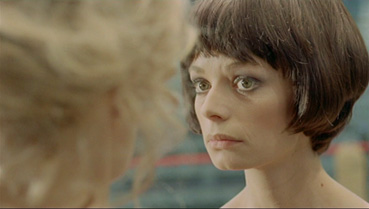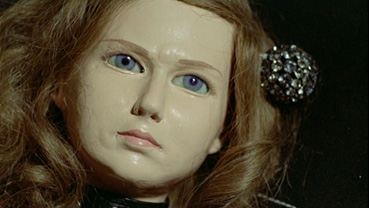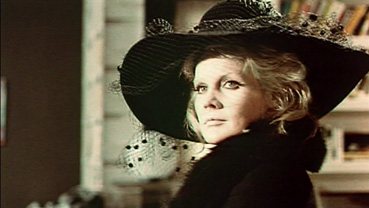|
Like my patient editor, I do have something of a fondness for genre titles that spell out the basics of the plot. I mean seriously, who wouldn't want to see a film called I Married a Monster From Outer Space? You know what you're getting there. But G.P. 506? What the hell is that about? (It is, I should point out, a rather good military/horror crossover, but still...) But in the realm of what-the-fuck? titles, Baba Yaga should surely be up for some sort of prize. Two words that together mean nothing in English. I'm not sure they mean a whole lot in any language, except perhaps to a newborn baby.*
So what, or who, is Baba Yaga? No clues in the first scene, a mind-bogglingly peculiar affair set in a graveyard involving Native Americans, cavalry soldiers, castration and ritual flag burning. Then the cops turn up and everybody scarpers. The opening credits don't help and nor does the scene that follows, which sees pretty photographer (they always are) Valentina talking the politics of revolution with a young group that includes a twerp named Arno, who directs jaw-droppingly racist commercials in which a Caucasian soap powder man (who in the English language version is called Mr. White) evaporates a nasty negro stain. Honestly, you have to see this to believe it.

It's not until Valentina decides to walk home alone at night that you suspect that we might get clued in to what the film is actually about. Misdirection comes when Valentina stops to pet a "nice doggie," which instead of savaging her as expected just sits in the road like an idiot and nearly gets hit by a car. The vehicle stops and its driver is treated to a Terminator 2 style foot-to-face reveal, only instead of a murderous Austrian cyborg we get an elegantly dressed middle-aged woman. She gives the startled Valentina a lift, but before dropping her off takes a clip from her passenger's garter belt, which she promises to return the following day. This interesting creature, it turns out, is Baba Yaga. And there's clearly something not quite right about her.
Any doubts about Baba's oddness are soon dispelled when she turns up at Valentina's studio appartment the following day and gets visibly turned on both by Valentina herself (understandable) and her camera (well it is a twin lens Rolleiflex knock-off). She gives the latter a loving fondle and proclaims that it's "the eye that freezes reality," which is a pretty good definition of what street photography is all about. But the eerie music and the slow camera moves suggest there's more to it than that. And there is. When Valentina photographs Arno's two-man film crew, their Arriflex locks up, and when she points it at cowboy-dressed model Toni, the poor girl collapses on the spot. Things get a notch or two weirder when Valentina visits Baba's ageing house, where she discovers a bottomless pit hidden under the hall carpet and a room full of S&M gear upstairs. Here she encounters a thrill-dressed doll named Annette, which Baba gives her as a good luck charm. Hmmm. As you might expect, Annette proves to be slightly more than your average dolly.
Baba Yaga is a curious but consistently engaging beast. Once you get past the oddball opening, the central story plays out clearly enough and with a number of pleasing kinks, with nice girl Valentina threatened not by the usual murderous male but a lesbian witch with a fondness for S&M. The presentation is not exactly by the book either, with director Corrado Farina peppering the narrative flow with flashbacks, semi-subliminal edits, peculiar Nazi dream sequences and gentle eroticism. Note that last one. Baba Yaga was made back in 1973 when even full frontal nudity was frowned on, so if you're expecting raunchy lesbian sex scenes or serious sadomasochism you're probably in for a disappointment. Indeed, it's the passing of time that must take the blame for the somewhat timid climax and a final revelation that's been reused a few too many times since to prompt even a small gasp of surprise today.

But the journey there is a good deal of fun. The concept of a camera with the power to freeze the workings of objects – whether they be the cogs of a cine camera or the human heart – is a smart one and is well implemented here. The same goes for the demon doll Annette, whose subtle shifts of position and expression have their roots in Dead of Night's Hugo and prefigure the creepy delights of Fats from Magic and even our old friend Chucky. Her later transformation into human form should raise a few smiles of delight, though she's given a run for her money by Baba's own air of erotic suggestion, a nicely understated turn from American actress Carroll Baker.
Technically, the film is both polished and adventurous. The rendering of a sex scene as a series of comic book frames (and borrowings from the opening scene of Godard's Une Femme Mariée, whose director is name-checked in an earlier sequence) may have been prompted by censorship dodging, but it's at least a creative solution that links the film to its Guido Crepax comic origins. Particularly impressive is the sometimes sleight-of-hand editing, used both to disorientate and throw small clues at the viewer, and has both the fractured narrative feel of late 60s experimentalism and the slickness of a more recent work. Having not seen the original cut, how much of either is down to director Farina's re-edit for this release I cannot confirm, but there is some similarly smart work in the cinematography, something we can be reasonably sure has not been retooled for the new version.
Baba Yaga is an imaginatively devised and constructed oddity that's best enjoyed with the knowledge that it's just not going to deliver on the increasing promise of its build-up. But see it in the context of its time, when the sexually adventurous were still often labelled as deviant and their activities alluded to but not shown on screen, and it more than justifies its rediscovery and digital resurrection.
This 'final cut' of the film is effectively a reconstruction carried out by director Corrado Farina in an effort to return it as closely to his original edit as possible, including the re-insertion of a couple of cut scenes and censored shots. The previously available version had been recut by the producers behind Farina's back, a re-edit that that was taken through to the negative cut, the final stage of an edit that once carried out is – or at least used to be – impossible to reverse, as the cement join made on each edit (it's a technique known as A/B roll negative cutting if you want to look it up) would involve destroying the frame on which the join was made. Thus to bring the film to anything close to his original vision, Farina has had to draw on what looks like either a slash print (a low quality print made from the negative that editors would use to cut the film in pre-digital days) or a low band video transfer for the missing material. In his interview in the extra features, Farina admits that some shots were impossible to re-insert because of these very problems. As a result there are some sudden and drastic shifts of quality here and there, but given the circumstances this is something we should accept as inevitable and be grateful that we can see at all. The sequences in question are short, sometimes only a small part of a single shot, and some aren't as bad as you might expect. Certainly overall the quality of the picture is rather good. Framed 1.78:1, anamorphically enhanced and slightly windowboxed, its contrast and sharpness are sound, though the colour has lost some of its punch with the passing of time. There are also some occasional but very noticeable motion glitches on panning shots. The rescued material stands out a mile, having generally weaker colour and less accurate contrast and sometimes accompanied by a blizzard of dust and dirt, but such is the price we have to pay and as I said before, they don't last long. Unusually for Shameless, there is no front-of-film warning of this.

The sound is mono and rather basic, although the English dub has a bit more volume and solidity than the Italian, which sounds rather tinny in places. Dialogue differences between the two tracks abound, from the subtle – "Am I too early?" on the Italian track becomes "Am I late?" on the English – to more drastic alterations where dialogue on the Italian track has been completely abandoned on the English (when Baba lights a lamp in the last act, for example). A personal favourite sees an elongated "Fantastico!" on the Italian track become "Oh it's utterly fantastic! How did you do it Captain White?" Amusing also to see the Italian "Ciao" subtitled as, well, "Ciao."
Textual commentary
Another track provided by the Wilson Brothers along the lines of their previous effort for Shameless on the Watch Me When I Kill disc. Once again this is a mixture of worthwhile info, pointing out the obvious, and lame comments about the on-screen action ("Man, look at that funky phone!" and so forth). There is interesting stuff here on composer Piero Umiliani, Guido Crepax and the censoring of the film, amongst other things, but there is the nagging sense that this would have been better done as a stand-alone essay, then we wouldn't have to wait...so...long...for...the...next...line...to...appear.
Corrado Farina Interview (19:57)
A fast moving and information-packed interview with director Farina, who talks about the Crepax cartoon strips, the characters, the re-cutting of the film that took place behind his back and a lot more. Intriguing to hear that he feels the film was miscast and that he didn't get any of the actors he really wanted for the lead roles, and that he regards the in-film emulation of Crepax's graphic panels as "one of the few reasons why the film is still interesting today." A compelling extra that provides a lot more info than the textual commentary.
Freud & Fumetti (11:36)
A short film directed by Farina that takes a lightning trip through the history of comic books in Italy, settling on and devoting the lion's share of the running time to the work of Guido Crepax. Interesting but breathless – the subtitles do well to keep up with the speedy narration.
Fumettophobia (12:23)
A lively, fast-moving and wittily executed assault on parental 'comic phobia' (which is what that title means) that makes a case for their recreational and educational value, especially for kids. Also directed by Farina, it's not in bad shape, but is slightly blighted by the constant presence of the yellow Shameless logo in the bottom right corner.
Theatrical Trailer (3:22)
Is this really the original trailer or a new construct by Shameless? Hard to be sure.
Gallery (5:00)
Rolling gallery of production stills set to the Piero Umiliani's score. Includes a few posters and video covers.
Trapped in time a little by censorship, racial attitudes and the recycling of ideas since, Baba Yaga still has plenty to recommend it, in its plotting, in bondage doll Annette, and in Baba herself, the sort of witch many would be happy to be tormented by. Great work by Shameless here in facilitating this restoration on director Farina's part, and the extras are decent as well. Definitely one for the collection.
|